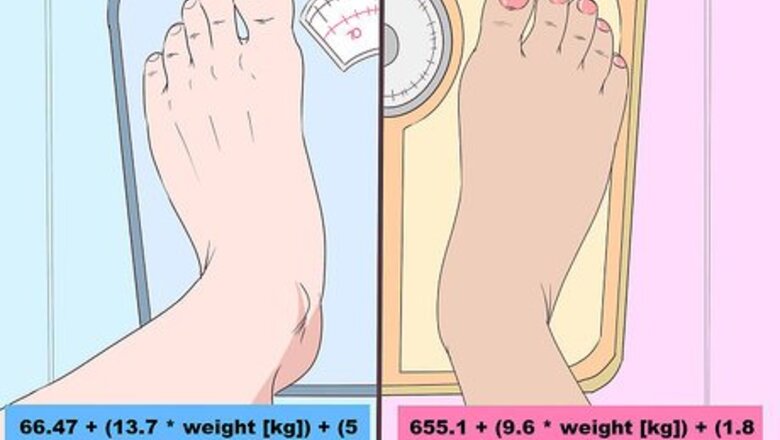
views
Calculating Your Calorie Needs
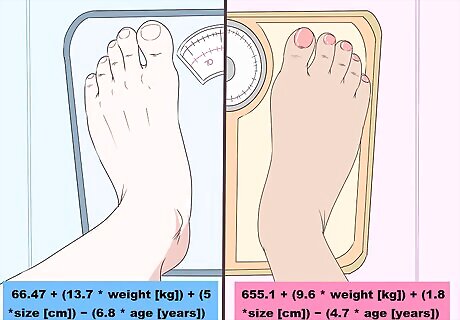
Calculate your basal metabolic rate (BMR). Your BMR will tell you how many calories your body needs to function properly if you spent the entire day doing absolutely nothing. This is also known as your metabolic rate or metabolism. Your body burns calories just to fulfill life-sustaining processes like breathing, digesting food, repairing and growing tissue and circulating blood. You will use the results from the BMR equation to find out how many calories you need to either lose weight or maintain your weight. Use the following equation (known as the Harris Benedict Equation) that is commonly used by health professionals to determine calorie needs. for men: 66.47 + (13.7 * weight [kg]) + (5 * size [cm]) − (6.8 * age [years]) Use the following equation for women: 655.1 + (9.6 * weight [kg]) + (1.8 * size [cm]) − (4.7 * age [years])
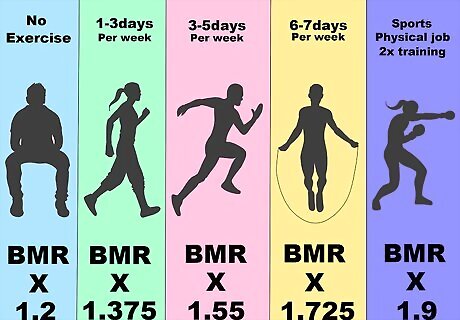
Account for your activity level. In addition to essential bodily functions, you must also account for the calories you burn through daily activity. Once you have your BMR, multiply your BMR by the appropriate activity factor: If you are sedentary (little or no exercise) : BMR x 1.2 If you are lightly active (light exercise/sports one to three days/week) : BMR x 1.375 If you are moderately active (moderate exercise/sports three to five days/week) : BMR x 1.55 If you are very active (hard exercise/sports six to seven days a week) : BMR x 1.725 If you are extra active (very hard exercise/sports and physical job or 2x training) : BMR x 1.9 For example, a 19-year-old woman who is 5’5” and 130 pounds would plug her information into the calculator and find out that her BMR is 1,366.8 calories. Then, since she is moderately active, exercising three to five days per week, she would multiply 1,366.8 by 1.55, to equal 2,118.5 calories. That is the number of calories that her body burns on an average day.
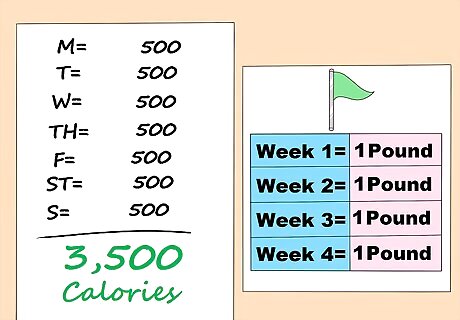
Calculate your total calorie needs for weight loss. In order to lose 1 pound of fat each week, you must have a deficit of 3,500 calories over the course of a week. Cutting out about 500 calories each day will result in a 3,500 calorie deficit over the course of the entire week. Only aim to lose 1 or 2 pounds per week. If you were to lose weight through diet alone, you'd need a 500-calorie deficit every day to lose one pound in a week. If you were really pushing it and wanted to lose 2 pounds in a week, you'd need a 1,000-calorie deficit every day. Aim to cut calories out by decreasing how much you eat in addition to burning off calories through physical activity. This combination generally produces the most effective weight loss.
Using Calories Calculations to Manage Your Weight

Keep track of how many calories you currently eat each day. When you first start your attempt to lose weight, it may be helpful to keep track of how many calories you're currently eating. Keep a food journal or use an online calculator to help you get an estimate of how much you currently consume. Compare this amount to your calculated and activity-adjusted BMR. If the numbers aren't even remotely close, it may be easier to start your diet by consuming your calculated amount of calories daily. Consuming a significant amount of calories less than you're typical day might be difficult. Decrease slowly by first adjusting your diet to line up with your activity-adjusted BMR level. EXPERT TIP Laila Ajani Laila Ajani Fitness Trainer Laila Ajani is a Fitness Trainer and founder of Push Personal Fitness, a personal training organization based in the San Francisco Bay Area. With over 10 years as a trainer and exercise specialist, Laila has expertise in competitive athletics (gymnastics, powerlifting, and tennis), personal training, distance running, and Olympic lifting. Laila is certified by the National Strength & Conditioning Association (NSCA), USA Powerlifting (USAPL), and she is a Corrective Exercise Specialist (CES). Laila Ajani Laila Ajani Fitness Trainer Understanding how to achieve a calorie deficit is essential for losing weight through your diet. A calorie deficit occurs when you consume fewer calories than you burn. You can reach a calorie deficit by controlling your daily calorie intake. If you're only engaging in low-intensity activities, women could aim for something like 1,200-1,500 calories per day, while men could aim for 1,400-1,600 calories.

Don't eat less than your calculated BMR. It's a bad idea to consistently make your daily caloric intake lower than your BMR. When your body doesn't take in enough calories each day to sustain basic functions, it starts burning muscle for energy. This will make maintaining your weight loss more difficult in the long run. Very low calorie diets aren't typically considered safe or appropriate for weight loss. They do not provide enough flexibility for you consume an adequate amount of protein, vitamins or minerals that are essential to your health. Try to keep consume at least 1,200 calories daily. This is generally recommended to by the absolute lowest amount of calories to take in daily.
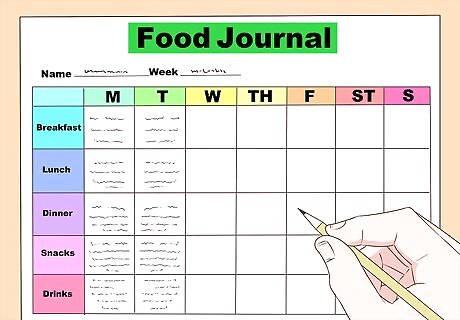
Keep a food journal. Consider keeping a food journal that lists everything you eat, as well as the calories per serving and how many servings you had. Studies show that those who journal their foods regularly stick to their diet plans longer and lose more weight. Search online for free apps or websites that allow you to enter what you ate — some will even calculate the calories for you. Try MyFitnessPal or Super Tracker by the USDA. You can also log your activity level and the amount of exercise you get each day. Seeing the actual amount of calories you consume each day will force you to take responsibility for your health and cut back on eating. Be vigilant about logging everything that goes into your mouth, and you'll find it's easier to stick to your diet.
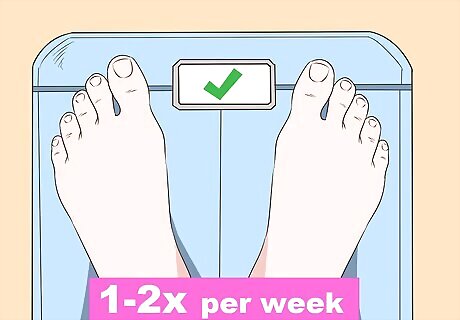
Weigh yourself regularly. Another important component of weight loss is tracking your weight and overall progress. Studies have shown that those dieters who weighed themselves regularly were more successful long-term than those who didn't keep track on their weight. Weigh yourself about one to two times per week. Try to get on the scale at the same time of day (try for first thing in the morning after you've just emptied your bladder) while you're wearing the same clothes for the most accurate record of progress. If you're not losing weight, reevaluate your total calorie intake. You may need to cut out more calories or be more accurate with your food journaling.















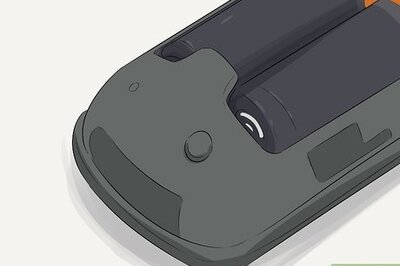




Comments
0 comment